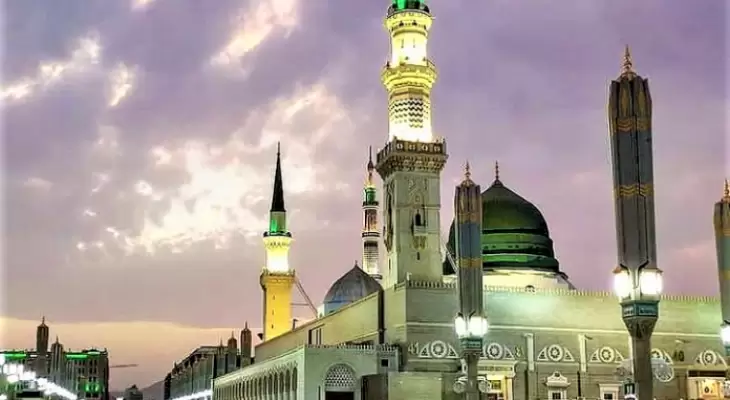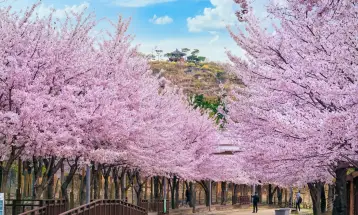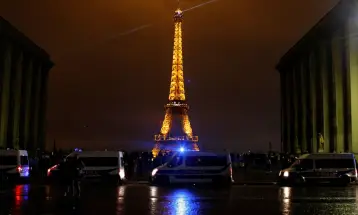Getting to Know About the Prophet's Mosque, the Building is So Magnificent and Beautiful With Super Sophisticated Technology

Holiday Ayo - For Muslims, the Prophet's Mosque is the second holiest place after the Grand Mosque in Mecca. The Prophet's Mosque in the center of Medina, Saudi Arabia is one of the largest mosques in the world.
Currently, the Prophet's Mosque has an area of 100,000 square meters with an upper floor area of about 67,000 square meters and an area of the courtyard of the mosque of about 135,000 square meters.
This mosque can accommodate around 535,000 worshipers. The Prophet's Mosque was also built with such magnificent decorations equipped with advanced technology. The state of Saudi Arabia spent billions of riyals on this expansion.
With stunning architecture and technology, making the Prophet's Mosque looks beautiful, majestic, and amazing. The beauty of this mosque lies in its technology, architecture, management, efficiency, and precision, from the interior to the exterior.
The building complex and the mosque's courtyard are equipped with 250 automatic umbrellas installed to protect the congregation from the hot and rainy weather.
Each umbrella is equipped with its own irrigation system and can protect about 800 worshipers and is able to cover an area of 143 square meters. The umbrellas that open automatically were designed by German architect Mahmoud Bodo Rasch and his firms Rasch GmbH and Buro Happold.
The Prophet's Mosque is the third mosque built in Islamic history, which is also one of the three mosques that Muslims are recommended to visit by traveling long distances. Other buildings around the mosque are various government offices and health facilities and main roads. The Prophet's Mosque is also the main destination for Hajj and Umrah pilgrims.
Privileges of the Prophet's Mosque
Inside the Prophet's Mosque, there are several locations that are very historic for all Muslims, one of which is eating the Prophet, Muhammad. Well, the tomb of the Prophet Muhammad was placed at the location where the prophet died, which was the room of Ayesha, the prophet's wife. Then the next also buried Abu Bakr and Umar bin Khattab in the same place. And now, the three tombs are inside the Prophet's Mosque, which is located in the southeast corner of the mosque.
One of the most famous places in this mosque is Raudhah or Raudhatul Jannah. The raudhah room is not too wide, which is about 330 meters with a length of 22 meters and a width of 15 meters, and is located between the pulpit and the tomb (formerly the house). For those who pray in this place, it is believed that their prayers will be answered by Allah. Usually, the pilgrims and Umrah often scramble to enter this place to pray and pray.
Inside the Prophet's Mosque, there are also two mihrabs, which is a place for the imam to lead congregational prayers in the mosque. The first mihrab was built directly by the Prophet Muhammad, then the second mihrab was built by Caliph Uthman bin Affan.
In addition to the mihrab, there is another holy place that identifies as a place of prayer, namely the mihrab al-tahajjud which was built by the Prophet Muhammad to perform the tahajjud prayer.
Another uniqueness that is quite impressive is the opening of the dome of the mosque. So, occasionally the roof of this magnificent mosque can be opened and show the beautiful horizon of the sky, especially at night where the stars can be seen.
History of the Founding
The Prophet's Mosque is the third mosque built in Islamic history. Before it became a mosque, this location was a place for drying dates belonging to the children, namely the brothers, Shal and Suhail bin 'Amr. This land was finally purchased by the Prophet Muhammad for 10 Dinars. This land is where the Prophet's camel first stopped in Medina. Then the Prophet's Mosque was founded in 622. The Prophet's Mosque stood next to the house where the Prophet Muhammad lived. The construction of the mosque was carried out directly by the Prophet Muhammad with his companions and other Muslims.
At that time, the walls of the mosque were made of bricks and earth, then the roof was made of palm fronds with support pillars of date palms. Part of the roof was left open and for the first nine years, the mosque was not lit at night. Only when Isha was given a little light by burning straw. When it was first built, the size of the Prophet's Mosque was about 50 x 50 meters with a roof height of about 3.5 meters. In its development, the Prophet's Mosque also underwent many renovations.
The first overhaul or renovation was carried out at the time of Caliph Umar bin Khattab, namely in 17 H, then it was renovated for the second time at the time of Caliph Uthman bin Affan, namely in 29 H.
During the reign of Caliph Umar bin Khattab, the Prophet's Mosque was enlarged. All houses around the mosque were razed, except for the house of the Prophet Muhammad.
In addition to the house of the prophet, there is also a place for poor people who do not have a home in this mosque area, they are called ahlussufah or residents of the mosque terrace.
The Prophet's Mosque was the first place to be illuminated by electric lighting in the Arabian Peninsula which was carried out in 1909, along with the installation of lights in the Arabian Peninsula. And during the Umayyad al-Wahid 1 Sultanate, this mosque was expanded on a large scale. A place was made which was above the final resting place of the Prophet Muhammad with his two companions, namely Abu Bakr and Umar bin Khattab.
In modern times, the era of the leadership of King Abdul Aziz of the Kingdom of Saudi Arabia in 1372 H, the Prophet's Mosque has expanded to 6,024 square meters. This expansion was then continued by his successor, King Fahd in 1414 H so that the building area of the mosque almost reached 100,000 square meters which also included additions to the upper floor and the courtyard of the mosque which can be used for prayers.
Now the area of the Prophet's Mosque has been many times more than before, even wider than the city of Medina in the past.
The boundary of the city of Medina at that time was the tomb of Baqi, which at the time of the Prophet Muhammad was said to be on the outskirts of Medina.








Leave a comment